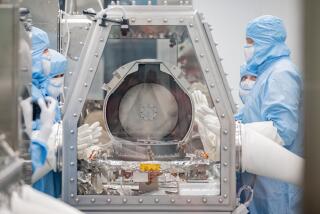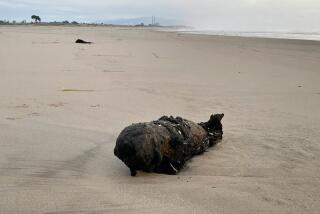Piece of Mars Finds Its Way to Museum
- Share via
It traveled millions of years through space, dropped into the Mojave Desert and was snatched up by rock collector Robert Verish.
Then, for 20 years, it was left unnoticed in a crate in his backyard.
It’s been a long journey for the so-called Los Angeles meteorite, now on exhibit at the Natural History Museum in Exposition Park. UCLA scientists have confirmed that the half-pound chunk of basalt came from Mars--one of only 14 Martian meteorites to have been found on Earth.
Verish rediscovered the rock last October only after his wife nagged him to clean up their backyard in Sunland, where dozens of crates full of rocks were attracting rodents. Verish, an engineering contractor at Pasadena’s Jet Propulsion Laboratory, is a weekend rockhound who had noticed the black meteorite during a walk in a desolate patch of the Mojave.
“The odds [against its discovery] are astronomical, and that’s not a pun,” Verish said. “So many different things had to happen. Why would a black rock get picked up in the desert? Why would I keep it?”
It happened so long ago that Verish said he’s not even sure exactly where he found the rock. But he picked it up partly because it reminded him of the slag rock he’d seen while growing up in Pittsburgh. It caught his eye again while he was cleaning up the yard.
“I couldn’t understand why I had [it] in with the agates,” Verish said. “I took it to UCLA to have them tell me what it was.”
It turned out to be an important scientific discovery--and an unexpected windfall for Verish after it was cut into pieces. He sold one chunk to a dealer for an undisclosed sum. Curator Tony Kampf of the Natural History Museum said, “It’s not unusual for Martian meteorites to sell for $1,000 a gram.”
The nondescript rock may prove most valuable to scientists, who will examine it for evidence of microscopic life on Mars. Four years ago, National Aeronautics and Space Administration scientists caused a stir when they said they had found fossil-like features in a similar meteorite, though many scientists remained skeptical.
Verish hopes his find will spur the discovery of other meteorites.
“Maybe some little kid will look closer at some black, shiny rock on the ground and be finding the next meteorite,” Verish said.






